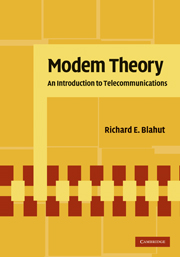Book contents
- Frontmatter
- Contents
- Preface
- Dedication
- 1 Introduction
- 2 Baseband Modulation
- 3 Baseband Demodulation
- 4 Sequences at Baseband
- 5 Passband Modulation
- 6 Passband Demodulation
- 7 Principles of Optimal Demodulation
- 8 Synchronization
- 9 Codes for Digital Modulation
- 10 Codes for Data Transmission
- 11 Performance of Practical Demodulators
- 12 Secure Communications
- Bibliography
- Index
2 - Baseband Modulation
Published online by Cambridge University Press: 05 June 2012
- Frontmatter
- Contents
- Preface
- Dedication
- 1 Introduction
- 2 Baseband Modulation
- 3 Baseband Demodulation
- 4 Sequences at Baseband
- 5 Passband Modulation
- 6 Passband Demodulation
- 7 Principles of Optimal Demodulation
- 8 Synchronization
- 9 Codes for Digital Modulation
- 10 Codes for Data Transmission
- 11 Performance of Practical Demodulators
- 12 Secure Communications
- Bibliography
- Index
Summary
A waveform channel is a channel whose inputs are continuous functions of time. A baseband channel is a waveform channel suitable for an input waveform that has a spectrum confined to an interval of frequencies centered about the zero frequency. In this chapter, we shall study the design of waveforms and modulators for the baseband channel.
The function of a digital modulator is to convert a digital datastream into a waveform representation of the datastream that can be accepted by the waveform channel. The waveform formed by the modulator is designed to accommodate the spectral characteristics of the channel, to obtain high rates of data transmission, to minimize transmitted power, and to keep the bit error rate small.
A modulation waveform cannot be judged independently of the performance of the demodulator. To understand how a baseband communication system works, it is necessary to study both the baseband modulation techniques of this chapter and the baseband demodulation techniques of Chapter 3. The final test of a modem is in the ability of the demodulator to recover the symbols of the input datastream from the channel output signal when received in the presence of noise, interference, distortion, and other impairments.
Baseband and passband channels
A waveform channel is a channel whose input is a continuous function of time, here denoted c(t), and whose output is another function of time, here denoted v(t).
- Type
- Chapter
- Information
- Modem TheoryAn Introduction to Telecommunications, pp. 31 - 57Publisher: Cambridge University PressPrint publication year: 2009
- 1
- Cited by



